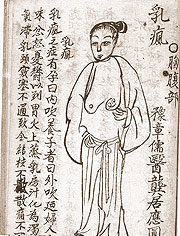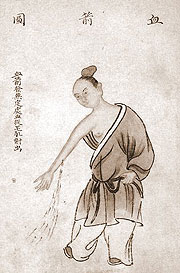 |
| Breast abscess |
In traditional Chinese medicine (TCM), internal medicine is the branch that deals with the diagnosis and treatment of internal organ systems, while external medicine is the branch concerned with the body's surface. In AD 1516, Wang Ji defined the scope of external medicine, wai kei, in his work Waikei Lili (Theory and Examples of External Medicine.) The book states: "It is called external medicine because diseases such as carbuncles, sores, wounds and ulcers are all visible from the outside." Thereafter, health problems that could be seen or touched directly, such as superficial infections, skin diseases, peripheral vascular problems, breast or thyroid lumps, male genital problems and piles as well as traumatic injuries, all came under the field of external medicine.
Unlike conventional medicine, TCM relies more on drug therapies than operative procedures for treatment of external conditions. The holistic view holds that the human body is an organic whole, with all parts being connected with one another by channels and collaterals (otherwise known as meridians). As a result, the internal is correlated with the external, and the exterior with the interior. For any superficial lesion, there must be deep influence to the internal system, and thus, treatment should cover both internal and external areas in order to exert both general and local therapeutic effects on the condition.
TCM external medicine first focused on serving the working class where wounds and infections more frequently occurred. This helped specialists accumulate knowledge on septic conditions and how to treat them using various local herbal remedies. From the Jin-Yuan Period onwards, physicians contributed significantly to the development of external medicine. A full set of pathological, diagnostic and therapeutic principles was also established at this time. Some classical works on external medicine are:
 |
Waikei Jingyao (Essence of External Medicine) |
Written by Chen Ziming in AD 1263, this work focuses on the importance of identifying the nature of septic conditions (including cold, hot, excess and deficiency conditions); it also employed an integrated approach to treatment (of internal methods alongside external methods). This book marks the establishment of external medicine and traumatic surgery as independent branches of medicine.
 |
Waikei Jingyi (Essentials of External Medicine) |
Written by Qi Dezhi in AD 1335, this book gathers together medical knowledge prior to the Yuan dynasty. By using a holistic view, the writer clarified that external diseases were mostly due to yin yang disharmony or blood and qi (vital energy) stagnations, and therefore diagnosis should be based on an overall analysis through the four examination techniques. He also formulated some guidelines for internal treatment methods.
 |
Waikei Zhengzong (Orthodox External Medicine) |
 |
| Arrow wounds |
Written by Chen Sizong in AD 1617, this large book records the medical achievements of the time, and precisely outlines various surgical procedures and cancer therapies. The writer advocated fortifying the spleen and stomach in managing surgical cases.
Generally, TCM holds that external diseases can be caused by various factors, for example the six evils, seven emotions, improper diet and long-term illness; however, other things including accidents, injuries, bites, burns, poisoning, drug reactions and frostbite are particular common in external diseases. According to TCM understanding, once a superficial lesion has developed, pathogens will first disturb the circulations of local muscles, tendons or bones, and result in redness, swelling, heat and pain. If the pathogens affect deeper and reach the organs , then systemic illness will appear. As the disease progresses further, stagnated blood and qi transform into fire evils, which give rise to tissue death and pus formation. After the pus-filled sore bursts and the pus disperses, new tissue regenerates and the sore will close and heal. TCM regards this as the usual cycle for such external conditions. Ancient physicians had realized very early that states of blood and qi inside the body determined the course of lesion development. Abundance in blood and qi not only facilitate the formation and release of pus, they also promote the regeneration and healing of the site. On the other hand, depletion of blood and qi will slow the cycle down and prohibit healing of the lesion. As a result, pathology in external medicine has a close relationship with the state of blood, qi, meridians and organs. Crucial factors leading to external conditions include blockages, disturbed flow, tissue decay and organ disharmony.
|